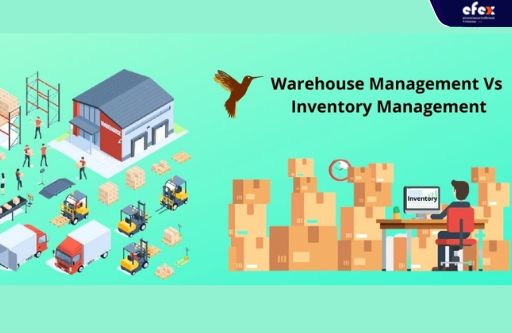
More Helpful Content
Inventory management and warehouse management are two factors that many businesses use in operating their company. They all have different strengths and weaknesses. So what is the difference between inventory management and warehouse management? Which software is your current business best suited for? Those questions will be addressed in this article.

Inventory management is the job of referring to activities such as inventory control, supply chain management, market demand forecasting, and reverse logistics. In a nutshell, this is the initial stage before moving to warehouse management. Safe stocking, product cost, order quantity, inventory turnover, supplier-managed inventory, and customer-managed inventory are all inventory management tools.
The level of necessity for inventory management varies by industry, however, most of the fundamentals of inventory management are constant. Inventory management is most effective for small companies when all the complexities are recognized and understood. With reduced investment in inventory, transportation costs, factory hiring, and reverse logistics, lean methods should continuously be implemented for every stage of the cycle.

Warehouse management involves controlling, moving, and storing goods in a warehouse. A warehouse management system is a software program or a system that manages these processes (WMS). WMS software allows users to centrally control warehouse management tasks such as locating goods and tracking inventory. Older WMS systems provided basic functions like where to store goods in warehouses, but today's warehouse operations applications can be so complex that a dedicated team is required to manage them.
Inventory management and warehouse management are closely related industries in which both contribute to the efficient transportation and storage of goods and both have an impact on inventory performance from suppliers. granted to the end-user. Each requires storage, re-stocking and delivery. The key links between inventory management and warehouse management are
- Read More: How much does it cost to build a warehouse in 2023?

There are some differences between warehouse management and inventory management. The complexity of inventory management and inventory management system solutions is the most notable difference. The Cargo management system provides users with complete information about the amount of inventory in a single area.
The warehouse management system, on the other hand, will be more complex because it will separate the repositories into many different segments and divisions. This is useful because it gives you full control of the repository storage system instead of just one location. The warehouse management system is not only that but also helps you locate specific things in the warehouse, while inventory management solutions can only notify you that they are somewhere in the warehouse.
In addition, unlike inventory management, warehouse management is an important step, and has a role and influence on the continuous operation of other departments. Here are some of the more important differences between the two systems that you should keep in mind.
Inventory management systems are often judged to be easier to use because they show the full amount of materials and goods in stock in a given storage location. Meanwhile, warehouse management systems are significantly more complex, as they give businesses full control of their warehouse storage systems. WMS can optimally manage multiple archives of a product in the warehouse, however, the inventory management system can only provide information about the amount of a single product there. cannot provide all of the information.
Inventory management is usually the initial stage in all warehouse procedures; however, warehouse management is more interconnected with the other components of the overall management system. WMS is interested in manufacturing supply sales and quality control and distribution. That is why it is always necessary for all operations in the warehouse.
When managing inventory, businesses are only given information about what their products are in stock and what their current quantity is. Warehouse management, on the other hand, allows businesses to precisely locate their storage areas. WMS gives businesses significantly more effective control over their operations by providing them with the information they need to perform other tasks.
With WMS, companies can change and evaluate inventory and storage on demand, while an inventory management system cannot do the same. WMS communication devices make it possible and simple to make these changes. This helps businesses have a clearer view of product and inventory location, leading to an honest assessment and reasonable operation, thereby improving the quality of work.
- Read More: 16 Warehouse Management Certifications To Enhance Your Career
- Read More: What is the warehouse management system (WMS)?
- Read More: SAP Extended Warehouse Management: Overview and Benefit

The choice between a Warehouse Management System and an Inventory Management System is primarily determined by the complexity and size of your operations, current sales volume, number of SKUs, and growth according to the plan. To make a wise choice, examine the full cost of a product over its lifetime (cost of the product, maintenance, installation, and updates) and compare them with the money saved Return on investment (ROI). Unlike the simplicity of an inventory management system, inventory management systems are often more complex.
The Inventory Management System can be installed after about 1 to 4 weeks and the monthly cost to maintain is also relatively low, suitable for small and medium businesses. The most expensive aspect of WMS is the setup cost, not the monthly product or SaaS fee. Deploying WMS can take anywhere from 2 to 8 months, with costs between $ 50,000 and $ 500,000. If your business currently has less than 1,000 SKUs and the average annual bill is less than $ 10 million and the biggest concern is knowing how much product is in your inventory and what more should be imported.
When to get the most out of your product, the IMS is ideal for you. However, if you have a large number of SKUs and handle hundreds of orders per day, you should consider a WMS. then expanded into WMS as their operations expanded.
Understanding the two concepts and the difference between inventory management and warehouse management is important. It will help you make reasonable decisions and optimize the investment for goods management tools.


